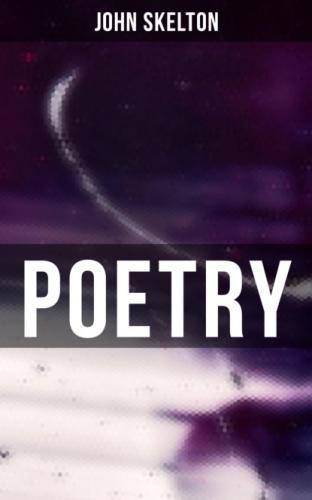Here begynneth a lytell treatyse named the bowge of courte.
Colophon,
Thus endeth the Bowge of courte. Enprynted at Westmynster By me Wynkyn the Worde. 4to, n. d.
On the title-page is a woodcut of a fox and a bear.
Here begynneth a lytell treatyse named the bowge of courte.
Colophon,
Thus endeth the Bowge of courte Enprynted at London By Wynken de Worde in flete strete, at the sygne of the sonne. 4to, n. d.
On the title-page is a woodcut of three men and a woman.
Here folowythe dyuers Balettys and dyties solacyous deuysyd by Master Skelton Laureat.
Colophon,
Cum priuilegio.
4to, n. d., and without printer’s name, but evidently from the press of Pynson. (Consisting of 4 leaves.)
On the title-page is a woodcut representing Skelton seated in his study, crowned with a laurel wreath, and over his head, “Arboris omne genus viridi concedite lauro” (see Memoir, p. xlvi. note).
It contains—
The ballad, “My darlyng dere, my daysy floure,” &c.
The verses, “The auncient acquaintance, madam, betwen vs twayne,” &c.
The verses, “Knolege, acquayntance, resort, fauour with grace,” &c.
The Latin verses, “Cuncta licet cecidisse putas,” &c., with an English translation, “Though ye suppose,” &c.
The verses, “Go, pytyous hart, rasyd with dedly wo,” &c.
Skelton Laureate agaynste a comely Coystrowne that curyowsly chawntyd And curryshly cowntred, And madly in hys Musykkys mokkyshly made, Agaynste the .ix. Musys of polytyke Poems & Poettys matryculat.
Colophon,
Cum priuilegio.
4to, n. d., and without printer’s name, but evidently from the press of Pynson. (Consisting of 4 leaves.)
On the title-page is a woodcut, the same as in the last mentioned tract, but with a different border.
It contains—
The verses mentioned in the title-page.
“Contra aliū Cātitātē & Organisantē Asinum, qui impugnabat Skeltonida pierium Sarcasmos.”
“Skelton Laureat uppon a deedmans hed yᵗ was sent to hym from an honorable Jētyllwoman for a token Deuysyd this gostly medytacyon in Englysh Couenable in sentence Comēdable, Lamētable, Lacrymable, Profytable for the soule.”
The verses, “Womanhod, wanton, ye want,” &c.
Honorificatissimo, Amplissimo, longeque reuerendissimo in Christo patri: Ac domino, domino Thomæ &c. Tituli sanctæ Ceciliæ, sacrosanctæ; Romanæ ecclesiæ presbytero Cardinali meritissimo, et Apostolicæ sedis legato. A latereque legato superillustri &c. Skeltonis laureatus Ora, reg. Humillimum, dicit obsequium cum omni debita reuerentia, tanto tamque magnifico digna principe sacerdotum, totiusque iustitiæ equabilissimo moderatore. Necnon presentis opusculi fautore excellentissimo &c. Ad cuius auspicatissimam contemplationem, sub memorabili prelo gloriose immortalitatis presens pagella felicitatur &c.
A replycacion agaynst certayne yong scolers, abiured of late &c.
Argumentum.
Crassantes nimium, Nimium sterilesque labruscas
(Vinea quas domini sabaot non sustinet ultra
Laxius expandi) nostra est resecare uoluntas.
Cum priuilegio a rege indulto.
Colophon,
Thus endeth the Replicacyon of Skel. L. &c. Imprinted by Richard Pynson, printer to the kynges most noble grace. 4to, n. d.
A ryght delectable tratyse vpon a goodly Garlande or Chapelet of Laurell by mayster Skelton Poete laureat studyously dyuysed at Sheryfhotton Castell. In yᵉ foreste of galtres, wher in ar cōprysyde many & dyuers solacyons & ryght pregnant allectyues of syngular pleasure, as more at large it doth apere in yᵉ proces folowynge.
Colophon,
Here endith a ryght delectable tratyse vpon a goodly garlonde or chapelet of laurell dyuysed by mayster Skelton Poete laureat.
Inpryntyd by me Rycharde faukes dwellydg [sic] in durā rent or els in Powlis chyrche yarde at the sygne of the A.B.C. The yere of our lorde god .M.CCCCC.XXIII. The .iii. day of Octobre, 4to.
On the title-page is a woodcut representing Skelton seated in his study, and on the reverse of the title-page a woodcut (copied from a French print—see Memoir, p. xlvii. note)—a whole-length figure of a man holding a branch in one hand and a flower in the other—having at top the words “Skelton Poeta,” and at bottom the following verses;
Eterno mansura die dum sidera fulgent
Equora dumq; tument hec laurea nostra virebit.
Hinc nostrum celebre et nomē referetur ad astra
Vndiq; Skeltonis memorabitur altera donis [alter Adonis].
On the reverse of A ii. are small woodcuts of “The quene of Fame” and “Dame Pallas.” After the colophon is the device of the printer, “Richard Fakes.”
Magnyfycence, A goodly interlude and a mery deuysed and made by mayster Skelton poet laureate late deceasyd.
Colophon,
Cum priuilegio.
folio, n. d., and without printer’s name.
In a note, vol. i. 225, I have (following Ritson and others) stated positively that this ed. was “printed by Rastell:” I ought to have said, that in all probability it was from Rastell’s press.
Here after foloweth the boke of Phyllyp Sparowe compyled by mayster Skelton Poete Laureate.
Colophon,
Prynted at London at the poultry by Rychard Kele.
12mo, n. d. On reverse of the last leaf is a woodcut representing Phyllyp Sparowe’s tomb.
An edition by Kele, 4to, n. d., is mentioned in Typogr. Antiq. iv. 305, ed. Dibdin: but qy.?
Here after foloweth a litle booke of Phillyp Sparow, compiled by Mayster Skeltō Poete Laureate.
Colophon,
Imprynted at London in paules churche yerde by Robert Toy.
12mo, n. d. On reverse of the last leaf is the same woodcut as in the ed. last described.
Here after foloweth a litle boke of Phillip sparow. Compyled by mayster Skelton Poete Laureate.
Colophon,
Imprinted at London in poules churchyard, at the sygne of the Sunne, by Antony Kitson.
Colophon in some copies,
Imprinted
